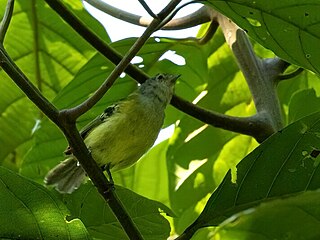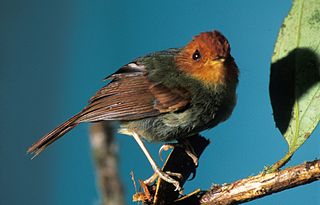
The bran-colored flycatcher is a small passerine bird in the tyrant flycatcher family. It is found in Costa Rica and Panama, on Trinidad, and in every mainland South American country except Chile.

The rufous-sided scrub tyrant, or rufous-sided pygmy-tyrant, is a species of bird in the family Tyrannidae. It is found in Bolivia, Brazil, Paraguay, and Suriname.

The rufous-breasted flycatcher is a species of bird in the family Tyrannidae, the tyrant flycatchers. It is found in Colombia, Ecuador, Peru and Venezuela.

The Inca flycatcher is a species of bird in the family Tyrannidae, the tyrant flycatchers. It is endemic to Peru.

The white-throated tyrannulet is a species of bird in subfamily Elaeniinae of family Tyrannidae, the tyrant flycatchers. It is found in Argentina, Bolivia, Brazil, Colombia, Ecuador, Peru, and Venezuela.

The white-banded tyrannulet is a species of bird in subfamily Elaeniinae of family Tyrannidae, the tyrant flycatchers. It is found in Bolivia, Colombia, Ecuador, Peru, and Venezuela.

The olive-chested flycatcher is a species of bird in the family Tyrannidae, the tyrant flycatchers. It is found in Ecuador and Peru.

The flavescent flycatcher is a species of bird in the family Tyrannidae, the tyrant flycatchers. It is found in Colombia, Ecuador, Peru, and Venezuela.

The unadorned flycatcher is a species of bird in the family Tyrannidae, the tyrant flycatchers. It is found in Bolivia and Peru.

The ochraceous-breasted flycatcher is a species of bird in the family Tyrannidae, the tyrant flycatchers. It is found in Bolivia and Peru.

The orange-crested flycatcher is a species of bird in the family Tyrannidae, the tyrant flycatchers. It is found in Colombia, Ecuador, and Peru.

The handsome flycatcher is a species of bird in the family Tyrannidae, the tyrant flycatchers. It is found in Colombia, Ecuador, Peru, and possibly Bolivia.

The Roraiman flycatcher is a species of bird in the family Tyrannidae, the tyrant flycatchers. It is found in Brazil, Colombia, Ecuador, Guyana, Peru, Venezuela, and possibly in Bolivia.

The spectacled bristle tyrant is a species of passerine bird in the family Tyrannidae, the tyrant flycatchers. It is found in Bolivia, Colombia, Ecuador, and Peru.

The rufous-headed pygmy tyrant is a species of bird in the family Tyrannidae, the tyrant flycatchers. It is found in Bolivia, Colombia, Ecuador, and Peru with at least one record in Venezuela.

The hazel-fronted pygmy tyrant is a species of bird in the family Tyrannidae, the tyrant flycatchers. It is found in Bolivia and Peru.

The Loja tyrannulet is a species of bird in the family Tyrannidae, the tyrant flycatchers. It is found in Ecuador and Peru.

The fulvous-faced scrub tyrant, or tawny-fronted pygmy-tyrant is a species of bird in the family Tyrannidae, the tyrant flycatchers. It is found in Ecuador, Peru, and possibly Colombia.

The mouse-gray flycatcher or mouse-grey flycatcher is a species of bird in the family Tyrannidae, the tyrant flycatchers. It is found in Colombia, Ecuador, and Peru.

The rufescent flycatcher is a species of bird in the family Tyrannidae, the tyrant flycatchers. It is found in Chile and Peru.























